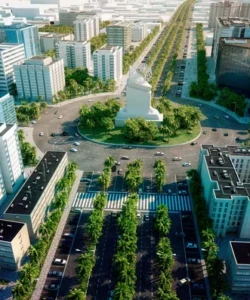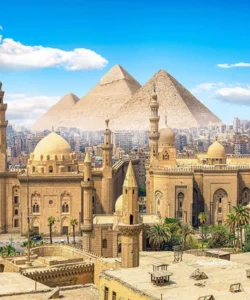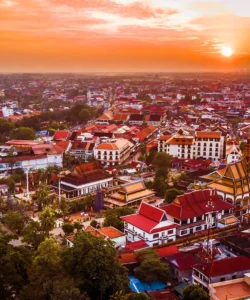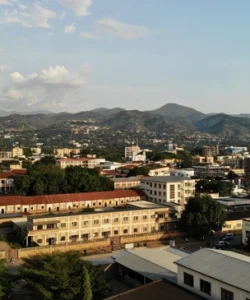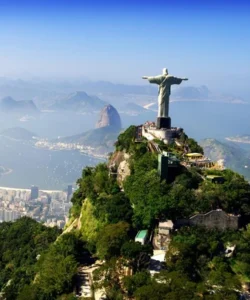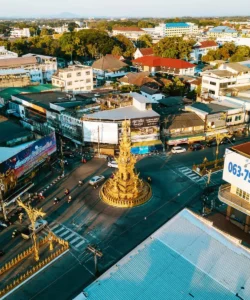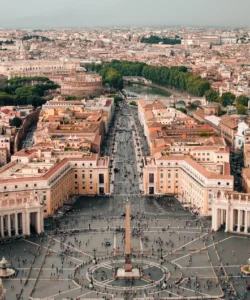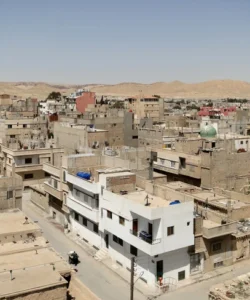Croatia, officially the Republic of Croatia, is a country at the crossroads of Central and Southeast Europe, on the Adriatic Sea. It is renowned for its stunning coastline, thousands of islands, rich history, and diverse natural landscapes ranging from pristine beaches to mountainous national parks.
Listen to an introduction about Croatia
![]()
Area and Population:
Croatia covers an area of approximately 56,594 km² (21,851 sq mi). As of early 2025, its population is estimated to be around 3.8 million.
Capital:
The capital city of Croatia is Zagreb.
Major Cities:
Besides Zagreb, other major cities include Split, Rijeka, Osijek, and Zadar.
Language:
The official language of Croatia is Croatian. English is widely understood and spoken in tourist areas, particularly along the coast.
Currency:
As of January 1, 2023, Croatia adopted the Euro (€) as its official currency, replacing the Croatian Kuna (HRK).
Religion:
The dominant religion in Croatia is Roman Catholicism, with the vast majority of the population identifying as Catholic. There are smaller communities of Orthodox Christians, Muslims, and others. A percentage of the population identifies as non-religious.
Attractions and Wonders:
- Plitvice Lakes National Park: A UNESCO World Heritage site, famous for its sixteen turquoise lakes interconnected by a series of waterfalls, cascades, and wooden boardwalks, set amidst lush forests.
- Dubrovnik Old Town: A UNESCO World Heritage site, often called the “Pearl of the Adriatic,” this perfectly preserved medieval walled city boasts stunning Baroque architecture, ancient fortresses, and a vibrant cultural scene. (Famously featured in “Game of Thrones”).
- Diocletian’s Palace, Split: A UNESCO World Heritage site, this ancient Roman palace forms the heart of Split’s old town, with a fascinating labyrinth of streets, shops, and restaurants within its walls.
- Hvar Island: One of Croatia’s most popular islands, known for its beautiful lavender fields, vibrant nightlife, historic town of Hvar, and stunning beaches.
- Rovinj: A picturesque coastal town in Istria, known for its charming old town built on a small peninsula, narrow cobblestone streets, and the towering Church of St. Euphemia.
- Pula Arena: A remarkably well-preserved ancient Roman amphitheater in Pula, Istria, still used for concerts and festivals today.
- Krka National Park: Famous for its cascades of tufa waterfalls, particularly Skradinski Buk, where swimming was previously allowed (now restricted) but offers beautiful natural scenery and historic mills.
- Zagreb’s Upper Town (Gornji Grad): The historic heart of Zagreb, with its charming streets, St. Mark’s Church with its colorful tiled roof, Lotrščak Tower, and numerous museums.
- Korčula Island: Believed to be the birthplace of Marco Polo, this island boasts a charming fortified old town, beautiful beaches, and a rich cultural heritage.
- Zadar’s Sea Organ and Greeting to the Sun: Unique modern art installations that harness the power of the sea and sun to create sound and light shows.
- Paklenica National Park: A dramatic mountain park popular for hiking and rock climbing, located in the Velebit mountain range.
Architecture:
Croatian architecture is a rich tapestry woven from various historical periods and foreign influences:
- Roman and Romanesque: Extensive Roman ruins (Diocletian’s Palace, Pula Arena) and numerous Romanesque churches (e.g., in Zadar, Rab) reflect early influences.
- Gothic and Renaissance: Cities like Dubrovnik, Split, and Trogir showcase magnificent examples of Gothic and Renaissance architecture in their cathedrals, palaces, and town squares. The Dalmatian region has its own distinctive Renaissance style, often incorporating local stone.
- Baroque: Prominent in Zagreb and parts of Slavonia, with ornate churches and palaces.
- Austro-Hungarian: Evident in cities like Zagreb and Opatija, featuring grand boulevards, public buildings, and elegant villas from the late 19th and early 20th centuries.
- Mediterranean and Coastal: Traditional stone houses with red-tiled roofs characterize the coastal towns and islands.
- Socialist Modernism: Remnants from the Yugoslav era, with some brutalist and functionalist buildings in larger cities.
- Contemporary: Modern architecture is emerging, particularly in new urban developments and coastal resorts.
Roads:
Croatia has a modern and continuously improving road network, especially along its main tourist routes.
- Motorways (Autoceste – A-roads): An excellent network of modern, well-maintained multi-lane motorways connects major cities like Zagreb, Split, Rijeka, and Zadar, and stretches down the coast. Most motorways are tolled.
- State Roads (Državne ceste – D-roads): A comprehensive network of main roads, often scenic, connecting towns and regions not on the motorways. Quality can vary but is generally good.
- County Roads (Županijske ceste – Ž-roads): Secondary roads, sometimes narrower or less well-maintained, particularly in rural areas.
- Coastal Roads (Jadranska magistrala – D8): A highly scenic but winding coastal road stretching along the Adriatic, offering breathtaking views but requiring cautious driving.
- Signage: Road signs are clear and generally use Latin script.
Driving in Croatia is a good way to explore the country, especially the diverse coastal regions and national parks.
Hotels:
Croatia offers a very wide range of accommodation options, driven by its booming tourism industry.
- Luxury and Boutique Hotels: Abundant in popular coastal destinations like Dubrovnik, Split, and Hvar, and in Zagreb, offering high-end amenities and stunning sea or city views. International luxury chains are increasingly present.
- Resorts: Numerous large resorts can be found along the Adriatic coast, catering to families and offering a wide range of facilities.
- Apartments and Villas: Self-catering apartments and private villas are extremely popular, particularly during the summer season, offering flexibility and often great value.
- Private Accommodation (Sobe/Rooms): Many locals rent out rooms (sobe) or apartments, offering an authentic and often affordable experience.
- Campsites: Croatia has many well-equipped campsites, from basic to luxury, often located in beautiful coastal or natural settings.
- Hostels: Available in major cities and popular backpacker destinations.
Restaurants and Cuisine:
Croatian cuisine is highly diverse, reflecting its regional variations and historical influences. It can be broadly divided into distinct culinary regions: Continental, Coastal (Dalmatian), and Istrian.
- Coastal/Dalmatian Cuisine: Heavily influenced by Mediterranean (Italian, Greek) traditions, focusing on fresh seafood, olive oil, herbs, and vegetables.
- Riblje jela (Fish dishes): Grilled fish (riba na žaru), often simply prepared with olive oil, garlic, and parsley.
- Peka: A traditional slow-cooked dish where meat (lamb, veal, octopus) and vegetables are baked under a bell-shaped lid (peka) covered with embers.
- Pašticada: A traditional Dalmatian beef stew, slow-cooked in a rich sauce, often served with gnocchi.
- Crni Rižot: Black risotto, colored by squid ink, a flavorful seafood dish.
- Buzara: Mussels or scampi cooked in a broth of white wine, garlic, olive oil, and breadcrumbs.
- Pršut: Air-dried ham, similar to Italian prosciutto, often served as an appetizer.
- Paški Sir: Famous sheep’s milk cheese from the island of Pag.
- Continental Cuisine (Central Croatia, Slavonia): Influenced by Austro-Hungarian and Turkish traditions, featuring more meat, potatoes, and heavier sauces.
- Štrukli: A versatile dish of dough with various fillings (cheese, apple, pumpkin), baked or boiled.
- Zagrebački odrezak: A schnitzel-like dish, usually veal or pork, stuffed with ham and cheese.
- Čobanac: A rich and spicy shepherd’s stew, particularly from Slavonia.
- Sarma: Minced meat and rice wrapped in pickled cabbage leaves (also popular in Bosnia).
- Istrian Cuisine: Blends influences from Italy (especially Venice) and Central Europe, with a focus on truffles, olive oil, and seafood.
- Fuži/Pljukanci with Truffles: Traditional Istrian pasta often served with a rich truffle sauce.
- Istrian Prosciutto: A distinct type of air-dried ham.
- Desserts:
- Rožata: A Dalmatian crème caramel.
- Fritule: Small, fried dough balls, similar to doughnuts, often flavored with citrus zest and rum.
- Drinks:
- Wine: Croatia has a long winemaking tradition, producing excellent red (e.g., Plavac Mali, Teran) and white wines (e.g., Pošip, Malvazija, Graševina).
- Rakija: A strong fruit brandy, common throughout the Balkans, made from grapes, plums, or other fruits.
- Beer: Local breweries produce popular lagers.
- Espresso: Coffee culture is very strong, similar to Italy.
Dining experiences range from charming konobas (traditional taverns) and pizzerias to modern fine dining restaurants, especially in tourist hot spots. Fresh produce, locally sourced ingredients, and a strong emphasis on seasonal cooking are hallmarks of Croatian cuisine.


